Build Methods.
|
|
Ah , not so fast there young Gerald.
Just when the discussion was starting to get interesting. My first build, A Selway-Fisher Ranger 16 canoe called Polythene Pam was stitch and tape, although I have to confess I didn't tape the outside of the seams, I just filled the cracks with thickened epoxy and then sanded it smooth. She wasn't sheathed either, Paul Fisher didn't specify it and I wasn't going to add to the weight or expense. I used her for a few years and then passed her on to Paradox Pete Martin who used her quite a bit, don't know where she is now, she never phones. 
So Paul is right in saying that it is possible for a first time builder to get a good result with stitch and tape, but I would also say the stitch and tape has many pitfalls. I've seen some horribly wavy chines, covered with thick glass tape and all sorts of horrors. It is very easy to get stitch and tape wrong but for me the real benefit was I could scratch the boat building itch quickly and cheaply. After that I knew I wanted to build something a bit bigger and dare I say it, better looking. So I built Caitlin, an Iain Oughtred Whilly Tern. Clinker Ply, built from scratch, no CNC no templates just a set of plans showing the shape of the stems and moulds. You don't get the shapes of the planks, you have to take them off the moulds. 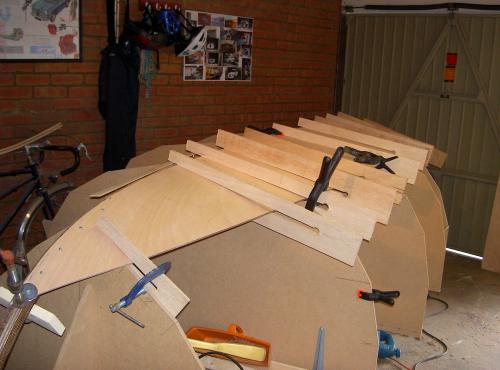 None of this is rocket science, it is obviously a longer process with more stages, but it isn't difficult. Its easy to get those plank edges nice and fair and the overlaps or "Lands" create a strong framework for the hull which doesn't require any ribs. The hull doesn't need to be sheathed, it is already a strong multi layer composite structure. So I think clinker ply is an excellent method for first time builders. It can prevent you making horrible mistakes, and is fairly light on the epoxy front compared to other methods. Taking advantage of CNC technology can save a lot of time and effort although it naturally adds to the cost. Oooh look at those lines 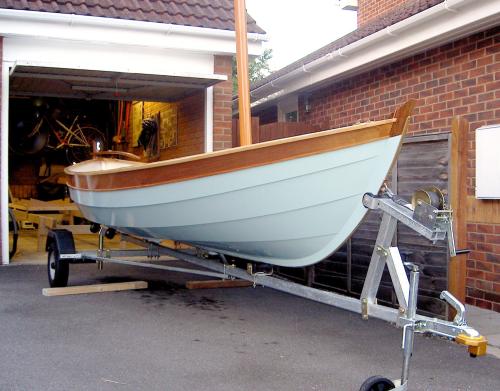 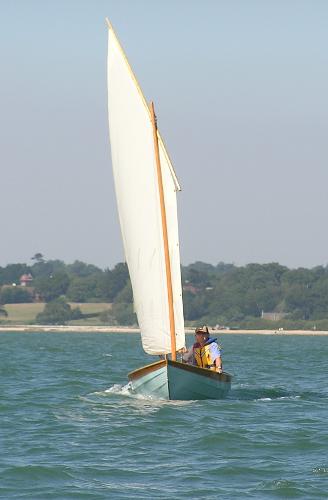 Notably Iain Oughtred has never sheathed a boat and the Late Great Jack Chippendale refused to teach us strip plank at Lyme Regis because a strip plank boat needs to be sheathed and he was dead against it. Each build method has its merits and of course its horses for courses depending on hull shape etc. but I don't think Clinker Ply is any harder or even more expensive than any other method. I now leave the floor open for others to contribute their own opinions. Go on you know you want to  Cheers then Grum. |
|
|
OK folks so here's my two-pennath. I love clinker-ply. As Grum says its not that difficult and presents lovely lines. My first Elf was CP and the panels went together beautifully, no sheathing and wonderfully strong except in traffic. The second one also went together like a dream. My first attempt at stitch and glue I found to be a pain in getting it to go together accurately and I have to admit the lines were not straight. Thereafter back to clinker ply. The Cally yawl- great. She's a big boat as a lot of you know but I could not think of trying it in stitch and glue and still maintain the beautiful lines. My latest is again clinker ply. Although the plans stipulated stitch and glue both Alec and myself both thought that clinker would look better and it was easy to make.
So I would not hesitate to go for clinker ply- strong, beautiful lines and no sheathing. You can't do the latter and keep the clean lines. Richard |
|
|
In reply to this post by Port-Na-Storm
Ahhh! Just as I was just getting comfy with my hibernation in my bin, curled up with my nose shoved up me arse!
To my mind strip plank is simple construction, once you have the strong back built, you don't need expensive tools or loads of clamps, just ordinary wood working tools. Getting the strip milled may be pricey, but few will have time,or the room to get planking cut & milled,how many can afford a pricey table saw to do that. Moisture curing glues, are simpler to use rather mixing batches of epoxy, nor are they temperature reliant, yes epoxy does have to be used for clear coating & sheathing, and perhaps laminating stem & breast hooks, and other hull furniture I think it comes down to what you want to build, and where you can do it, for canoes strip plank seems the way to go, CNC cut ply kits which slot together are more suited to complex builds, but then if you are to become a serial boat builder, ( did you ever think you would Grum?) Amassing all those tools makes it worth while. I did like the shot of the Whilly tern , I loves a double ender, but my dudgeon really got into a funk with a partial glimpse of the Tandem in the background, Dawes Galaxy at a guess! Just finished putting a hinge on my recumbent trike, it now folds! See you down the road. |
|
|
In reply to this post by Port-Na-Storm
On Fri, Feb 12, 2021 at 12:49 PM Port-Na-Storm [via UK HBBR Forum] <[hidden email]> wrote: Ah , not so fast there young Gerald. ring ring, ring ring, rng ring... Hello, this is Pam calling. I was last seen in a nice garage in Cheltenham awaiting getting my bottom wet again sometime in 2021. This was a change form the damp and draughty carport where my previous owner left me languishing whilst he defected to rotomolded plastic kayaks. He did take me for a farewell outing in July last year. It's rumoured my new owner might even take me on a Thames Raid in the future...  Best Wishes Pam |
|
|
In reply to this post by Port-Na-Storm
It's horses for courses in my experience.
MilliBee was designed as a coastal cruiser, for the rough and tumble of waves and drying out on stony sea beds. There is a long scrape from a rusty pontoon bolt on one side; it cut into the glass fibre/epoxy sheathing but not into the wood. Without the sheathing the ply would have been damaged. The floor has a puncture hole on the side I sleep; she settled on a stone and was rocked by wind driven waves. The outer shell coped well, again the glass avoided splintering of the wood. I'm confident that over 15 years the glass/epoxy outer shell protected my glorious pocket cruiser and was well worth the effort. Sheathing a smooth hull is as easy as wallpapering, but would be very difficult on a planked hull. For easy day sails, paint on wood is fine. Edit: CW reckons stainless strip on the keel is worthwhile, I'll be using 50mm wide strip because I know the keel ends up stripped of all paint by the sea bed. -Paul |
|
|
Get your dudgeon out of your funk immediately Gerald.
Well spotted on the Tandem front. You've got me wandering off down memory lane now. It wasn't a Dawes Galaxy I'm afraid. I bought it from a colleague by which time it had been re-enamelled and lost all indication of its provenance. It was believed to be of French origin, it had a mixte frame, cantilever brakes which didn't work very well and an extra drum brake on the rear to stop the passenger screaming. The big chain-ring had a lot of teeth and she could motor on once you hit terminal velocity. The frame was a bit whippy to say the least. If you didn't work absolutely Ahem, "In Tandem" it could set up a resonant frequency strong enough to throw all marital harmony into the nearest ditch.  Here she is, with me at the helm and my mate JP in the engine room thundering towards glory during the 1992 British Heart Foundation London to Brighton Bike Ride. I sold her on to another colleague whose marriage needed challenging when I got fed up moving her from one side of the garage to another every time I worked on the boat. Talking of things I don't own any more, how about this one? 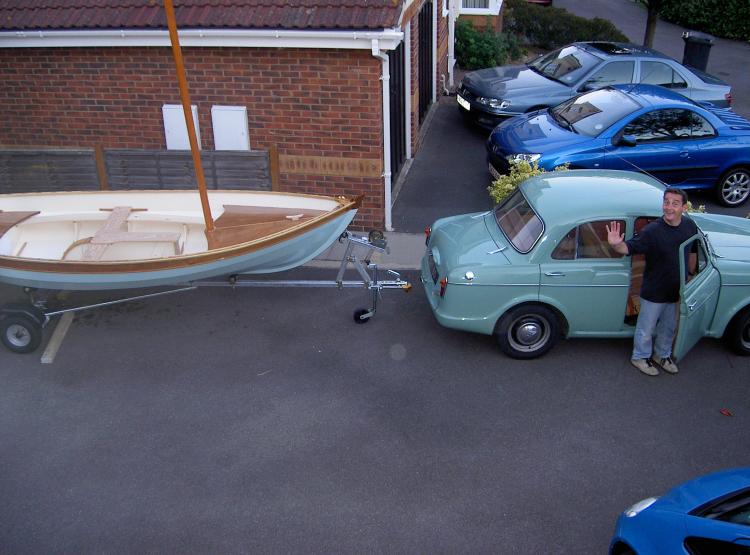 Obviously a set up as the Wolseley didn't have a tow bar but it was a nice thought. The Whilly Tern went to live in The Netherlands and was later sold on to a couple of brothers with young families. 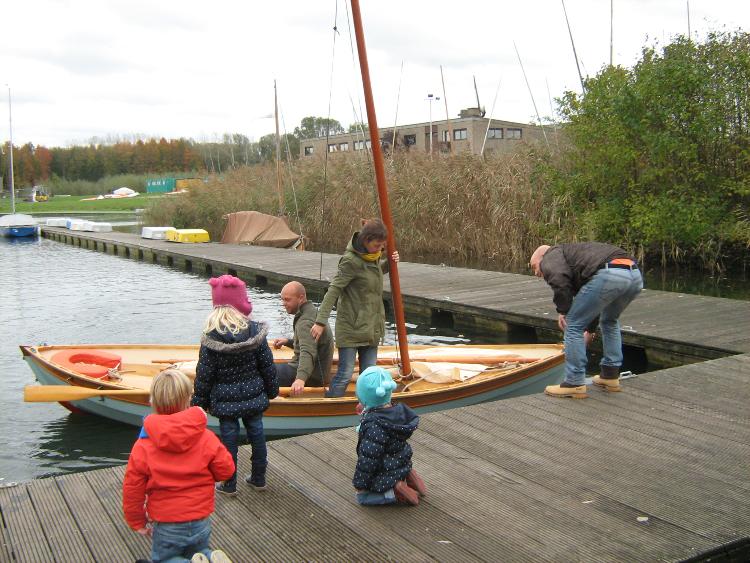 The Wolseley went off to retire in a barn near La Rochelle where she became a Frenchman's Fancy after I got fed up hiding the rust. 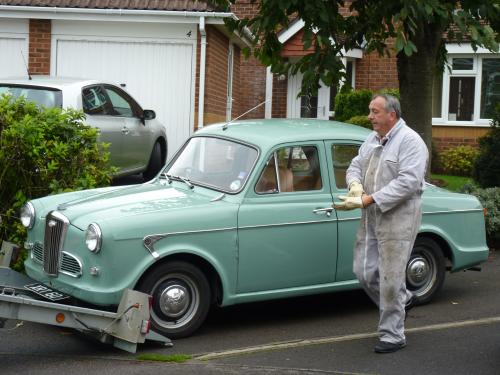 In fact most things eventually head off down the drive, otherwise it would get pretty congested around here.  Still Its nice to know they are still being looked after. The Coot went to Ditisham but wasn't being used so she's now been moved on to someone planning to sail her in Bristol Docks.  Anybody want to buy a Heron? 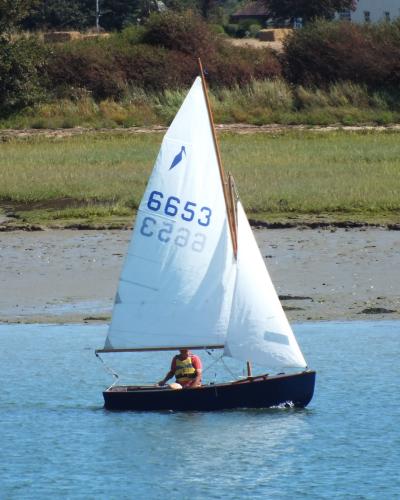 |
|
|
I thought this was a boat building forum, would talk about bikes all day Grum, but time to drag it back to boats.
I watched on youtube , someone had 'built' a canoe out of papier mache, used a finished canoe as his mould, one layer of glass sheathing , several layers of print , the first layer , ironically was a book on boat building, then a finishing scrim of glass fibre, gunnels and some thwarts to give it rigidity. He reported it as a bit flimsy, but paddle ok. But thinking on the technique is not too far away from skin on frame, without the framing. Sorry ,lost the link , to it unfortunately. P.s that Frenchie tandem may have been a Gitane or Motorbecane, mixte framing not good, marathon or double marathon is far stronger, but I doubt you'd go there again. |
|
|
My home designed boat was stitch and glue.. Once the ring frames were set up, a bottom plank and the two uppermost planks were stitched on, then bonded into place with fillets of thickened epoxy.
Then each next plank was offered up each side marked up to fit , trimmed, sewn on, then bonded inside and out. And repeat, No overlap she is carvel.. The Sewing was done with a non stretch very strong man Made fibre cord.. Which meant at the end it could be easily cut off and sanded smooth. Once all the planking was done, it was fill / sand, fill, sand then a coat of thin Glass fibre was bonded on inside and out.. |
|
|
In reply to this post by Port-Na-Storm
Cyclemiester,
How do the over 55s fare on a tandem? I've always loved to try one, assuming the correct person is leading and the rear saddle is lower for a "petite" person. 😀 Add electric assist and panniers and you get the Bill Gates "baby boomer net zero" award ha ha. I can imagine pleasant discussions on who peddled the most and wasn't it wonderful we missed the pot holes. Plywood cycle frames? They built Spitfires with plywood and string. Jolly sustainable chaps, tally ho. Paul Jabbed and euphoric |
|
|
Talking of bikes which we should not be doing on this forum I bought a Copenhagen Pedersen in the first lockdown and have really enjoyed gently cycling round our village without the need to wear lycra on something that looks a bit different from the the other modern bikes.
Chris A. |
|
|
Spitfires were a monocoque construction of Duralumin.
Hurricanes were a mixture of steel , Duralumin and wood covered in Doped linen. The Mosquitos were a body of ply / balsa / Ply layers, with wings of wood and covered in doped Linen. |
|
|
In reply to this post by Chris Adeney
Grums gonna need to retitle this thread.!
Nothing new is really coming up in the bike world the Pederson has been around since late 1890's, I had a scoot around one up at the York rally, nice ride, but beyond my meagre pockets them days. Paul , again wooden frames , been done ,at least pre war bamboo frames,, bonded into ally joints, and was quite common to be used in wheel rims for track racing, lightweight, strong, as it was for track no brakes were needed, there is a Brit building road frames now out of Ash, CNC machined puzzle joints bonded with epoxy, makes for light supple frames, Carbon fibre I'll wager is a new direction, but again that's not too recent a development. I've only ridden Tandem once, a few circuits around a running track on a vintage SWB 30's Saxby sat on the back, I found it weird at first, but soon started to push hard ,got told in no uncertain terms stop f**king pushing! But no reason not to start riding in your greying years, I've always wanted to ride a tandem recumbent trike,almost took the offer of one, but I have no where to keep such a beast, then a friend asked if I wanted to go try a two wheel recumbent tandem, thankfully the dealer is up in Edinburgh, but that still might happen. Must stop commenting on my other passion/ religion,, for that's what it is! |
«
Return to General Discussion
|
1 view|%1 views
| Free forum by Nabble | Edit this page |


